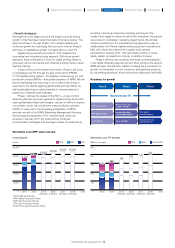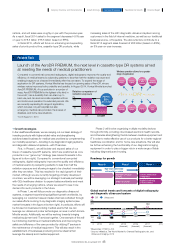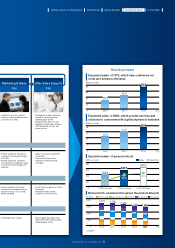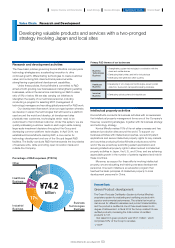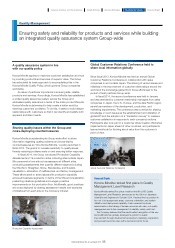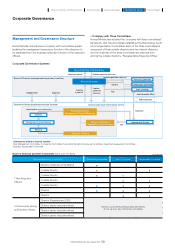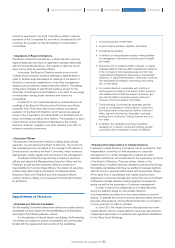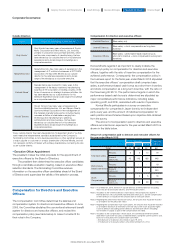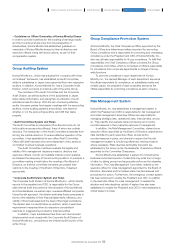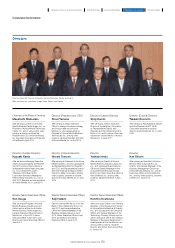Konica Minolta 2015 Annual Report Download - page 55
Download and view the complete annual report
Please find page 55 of the 2015 Konica Minolta annual report below. You can navigate through the pages in the report by either clicking on the pages listed below, or by using the keyword search tool below to find specific information within the annual report.
Upgrading our supply chain managementProcurement optimization
An efficient production system
Konica Minolta is building a unique system for centrally managing
inventory data from production to sales. This has facilitated
inventory optimization and shortened distribution leadtimes
worldwide, and allowed market demand to inform production
plans. Furthermore, in recent years we have raised the level of our
supply chain management by implementing the concept of Sales &
Operation Planning (S&OP), which involves integrating business
operation plans for procurement, production, distribution, and
sales based on demand and supply planning.
We have also optimized shipping efficiency by establishing
distribution centers in five key regional markets—Europe, North
America, Japan, China, and ASEAN—and consolidating routes for
getting products from production sites to markets.
To give a specific example of the success of these supply
chain initiatives, we were able to increase inventory in advance and
switch our unloading operations to the east coast when port
functions were disrupted on the west coast of the U.S. in 2014 due
to breakdowns in labor-management negotiations. These efforts
allowed us to avoid lost sales opportunities.
To ensure cost-effective, stable procurement, Konica Minolta builds
procurement ICT infrastructure and ensures optimal procurement
logistics from a global perspective, while at the same time
analyzing market changes such as exchange rate and raw material
cost fluctuations and industry restructuring, then applying the
knowledge gained to procurement activities.
Key to success here is engaging in Procurement Collaboration
to mutually improve business conditions with business partners in
order to build sound relations with them. In fiscal 2014, Konica
Minolta worked with its suppliers to launch Green Supplier
Activities. These activities aim to reduce costs and environmental
impact by providing business partners with Konica Minolta’s
environmental technologies and know-how.
We also address supply chain risks such as those involving
labor and human rights by conducting CSR procurement and
conflict mineral surveys.
At Konica Minolta, key parts and items that use Konica Minolta’s
proprietary technologies such as toners are primarily manufactured
in Japan. Our manufacturing contractors in Asia make the general
parts and units, and China and Malaysia handle final assembly.
This system improves equipment production efficiency and quality.
Our Chinese facilities have achieved high production efficiency by
leveraging expertise gained through 20 years of experience. To
hedge the risk of overconcentrating production sites in China, we
set up a new production facility in Malaysia in May 2014 and
expanded the range of products procured in ASEAN countries.
With the goal of further improving efficiency, we have
expanded modularity with a universal product platform that utilizes
our development technologies and have dramatically reduced part
and assembly costs. Going forward, we will seek to avoid reliance
on people, places, countries, and fluctuation and aim for even
better productivity by utilizing digital manufacturing (see pg. 14 for
more details) that combines ICT and automation technologies.
Value Chain Procurement, Production, and Distribution
Pursuing optimization throughout the supply chain while enhancing
cost competitiveness and practicing environmental conservation
On-site assessment conducted through
Procurement Collaboration
Focused Topic
Green Factory operations
Konica Minolta’s Green Factory operations aim to both reduce
environmental burden and cut costs through environmental
conservation activities in line with the production strategies of
each business. An example of this is how Konica Minolta
Business Technologies (Dongguan), which manufactures MFPs
and other products in the city of Dongguan in Guangdong
Province, China, is achieving significant energy savings by
improving the heating methods of its forming machines and
re-examining freezer temperature settings.
Cost reduction ¥5,264 million
CO2 reduction 84 ktons
Waste reduction 15 ktons
FY2014 reductions (compared to FY2005)
54
KONICA MINOLTA, INC. Annual Report 2015
Foundation for GrowthBusiness StrategiesGrowth StrategyCompany Overview and Characteristics Financial Report


